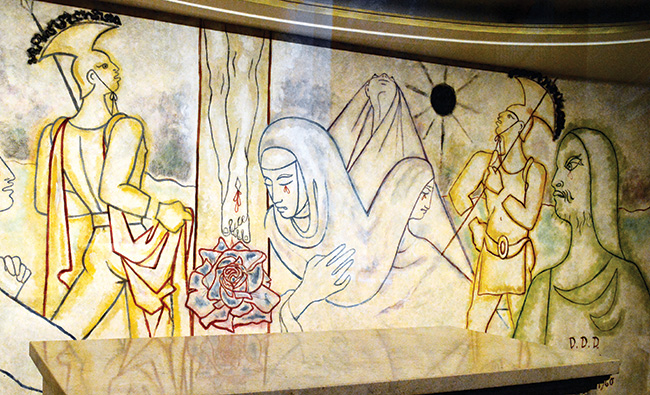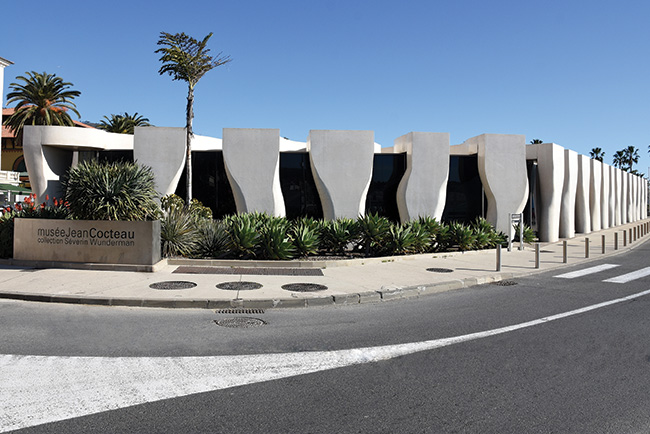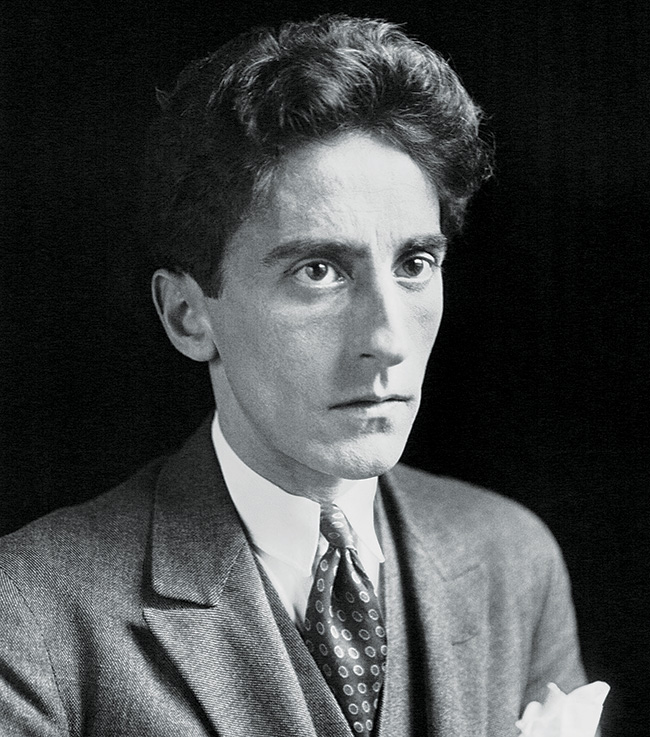Chloe Govan reveals how the “frivolous prince” and polymath fought off associations with the Nazis and a pornography scandal before finally finding peace on the French Riviera.
Jean Cocteau is well-known as a poet, fiction writer, actor and director, not to mention a key figure in the Parisian art world who counted Picasso and Modigliani among his friends. Yet how much do you know about the controversies in his life and how he sought to escape them on the French Riviera?
The tide began to turn for the once-respected creative when he publicly downplayed Hitler’s failings in the lead-up to the Second World War. This was an unusual move for an openly gay man, given Hitler’s apparent hatred of homosexual lifestyles.
Soon after he came to power, the Chancellor set about condemning gay men as “socially aberrant” menaces to be eliminated from society. He had Berlin’s Institute for Sexual Sciences purged, burning almost 12,000 books. By 1935, he’d made gay sex a criminal offence punishable by ten years in jail, and a few years after that, he gave the green light to castrate those unfortunate enough to find themselves behind bars. Then, in the war years, up to 15,000 gay men were banished to concentration camps, bearing a pink triangle to identify their “crime” – and many never made it out alive.

Cocteau photographed in 1923
Dubious Friends
All this, plus his disapproval of so-called “deviant art”, made him an unlikely symbolic ally for a gay man in the art world. But according to Cocteau, Hitler was waging an internal war against his own homosexual appetites. These eyebrow-raising allegations were echoed in Hitler’s Secret: The Double Life of a Dictator, a book by historian Lothar Machtan, who claimed: “Hitler himself never condemned homosexuality, but he allowed the persecution of gays in order to disguise his own true colours.”
The surprising sympathies Cocteau expressed towards the wartime dictator were probably forged during his friendship with sculptor and architect Arno Breker, notably the only German to exhibit in France during the Nazi occupation. He was undoubtedly a controversial figure due to his conflict of interests – he was despised by some for his kinship with Hitler and association with the Nazi regime, which paired dichotomously with his passionate friendships among the artistic community of Paris, where he had lived during the pre-war years.
Breker was technically a Nazi-sponsored artist, who had been pictured walking with Hitler in the occupied city. Allegations were being made about his “exploitation of the occupation economy”, purchasing the artwork of people from persecuted groups at unreasonably low prices. However, nothing deterred Cocteau from meeting this much-hated “representative of the enemy” in an apartment he stayed in at the Paris Ritz. He even wrote an article, “Salut à Breker”, in which he praised his artistic ability, poetically declaring that he’d transcended political and geographical boundaries with his work, side-stepping all animosity to deliver universally enjoyable art. The article took pride of place on Comoedia’s front page in May 1942 and was read by an estimated 50,000 open-mouthed Parisians. It was not, it seemed, how they viewed Breker. In fact, Breker himself recalled the first Frenchman he’d encountered while strolling through the city’s streets with the Fuhrer. “Il semblait pétrifié!” he wrote.
Breker claimed that he’d used his influence within the Nazi regime to prevent action being taken against Picasso and to release Jewish prisoners from jail. By the summer of 1944, Cocteau put pen to paper again in a journal entry lamenting that he was being treated as an enemy of the public because of his support of Breker. “Que me reprochet-on? D’être l’ami d’Arno Breker,” he wrote, insisting in his friend’s defence that “il a sauvé d’innombrables prisonniers”. Despite a seemingly near miss, Cocteau considered the fact that he was never found guilty of collaboration after the war a victory for art over war and real people over politicians.
He diced with political danger on another notable occasion when he involved himself in the imprisonment of fellow gay author Jean Genet. After a long string of convictions for theft, lewd acts and more, Genet was threatened with lifetime imprisonment, prompting his pals Cocteau, Picasso and Jean-Paul Sartre to step in and petition the President in his favour. They were successful and Cocteau allegedly went on to be the cinematographer for Genet’s 1950 film Un Chant D’Amour, a homoerotic 26-minute film that was long banned; a court in California, for instance, branded it “nothing more than hardcore pornography”.

Cocteau painted several murals inspired by the Virgin Mary © ANDYSCOTT
This was the last in a series of scandals for Cocteau, who afterwards left the opium-drenched arts scene of Paris for a slower pace of life in the south of France. Although Cocteau had been a prolific author, actor and playwright during his life – he even wrote one book in just one week while attempting to blot out the grief of bereavement – the most long-lasting trace of his creative legacy for those following in his travel footsteps can be found on the Riviera. His pattern of finding solace there began when the death in 1923 of his close friend, the writer Raymond Radiguet, at the age of just 20, left him inconsolable. He retreated to the Welcome Hotel in Villefranche-sur-Mer for an entire year in 1925.
Unfortunately, however, it took more than sunshine and ocean waves to heal his heart and he soon found himself in the grip of an opium addiction. That said, his celebrity friends were on hand to help and Coco Chanel famously footed a rehab bill for him. As the temptations of the roaring 20s faded away, and the stress of the capital became a distant memory, he began to cherish new memories made on the Riviera. He would declare that the best times of his life had been spent there by the sea, painting the fishermen.
In the 1950s, he decorated a nearby chapel, which had been ever-present on the skyline when he looked out from his hotel room’s balcony. Today, it’s easy for travellers to follow in his footsteps by checking into room 22 and soaking up exactly the same views. His movie scene artwork adorns the space, while the sea-blue walls above the bed carry one of his iconic quotes: “De temps en temps il faut se reposer de ne rien faire” (“From time to time you have to take a rest from doing nothing”.)

The 14th-century Chapelle Saint-Pierre at Villefranche-sur-Mer, which he brought back to life © Shutterstock
A Quieter Lifestyle
After a life of decadence, the man of excesses – who once famously said that “a little too much is just enough for me” – began to channel his energy towards decor. He started to make his mark not just in the transient world of theatre, but in places where he could have a long-lasting visual legacy, such as the buildings themselves. Some might say Cocteau immortalised his soul here on the Riviera – and visitors can reap the rewards.
The 14th-century Chapelle Saint-Pierre, a stone’s throw from the Welcome Hotel, was in a sorry state when Cocteau discovered it in 1956 – a mere convenient storage space for fishing nets or meeting place for the local fishermen’s association. He volunteered to bring the interior – and exterior – to life with his art, and the results prevail today.
The walls are instantly recognisable, projecting his trademark style – but revamping it was never simple. In fact, he recalled spending a painstaking three days painting the face of Christ more than 50 times before the final version was unveiled.
Besides this project, his footsteps can also be traced back to Santo Sospir, a villa owned by socialite Francine Weisweiller, across the bay in Saint-Jean-Cap-Ferrat. Barely a 15-minute drive away from the Welcome Hotel – or a scenic 50-minute ride if travelling by bus – this is yet another enduring memory of Cocteau’s work. He’d become friends with Weisweiller, who was barely more than half his age (the pair were 61 and 34 respectively at the time) and related to her need to seek escapism from her hectic life in the capital.
In May 1950, after her cousin appeared in a movie based on his book Les Enfants Terribles, Cocteau was invited to spend a weekend at Weisweiller’s elegant Côte d’Azur villa. It turned out to be somewhere he was reluctant to leave, and Cocteau soon got to work on the interiors.

The Jean Cocteau Museum in Menton © Shutterstock
He decorated the area above the fireplace with an illustration of Apollo the Sun God. From there, his work expanded and he ended up transforming every inch of space, using unusual pigments made from a mixture of charcoal and raw milk. Cocteau spent a total of 11 years living in the home he had painstakingly decorated. Ownership of the villa remains in the Weisweiller family, and visits can be arranged in advance. Meanwhile, further along the Riviera towards the Italian border lies the warm and balmy town of Menton, famous for, amongst other things, its lemon festival. Here you will find the Jean Cocteau Museum/Séverin Wunderman Collection on the beachfront, the Bastion museum, set in the 17th-century fort, which is packed full of his artwork, and the Salle des Mariages in Menton City Hall, which is also decorated with his frescoes. Finally, the Hôtel Napoléon boasts seafront rooms decorated with Cocteau’s artwork too.
Although he died close to his birthplace in Milly-la-Forêt, near Paris, in 1963, he left part of his heart on the French Riviera. Visitors to his old haunts are guaranteed a glimpse not just of his work, but also of the impassioned soul behind it, and the artist’s mindset when he told the world that poets “shed not only the red blood of their hearts but the white blood of their souls”.
From France Today magazine
Lead photo credit : Head to the beautiful town of Menton if you want to follow in Cocteau’s footsteps © Renek78








